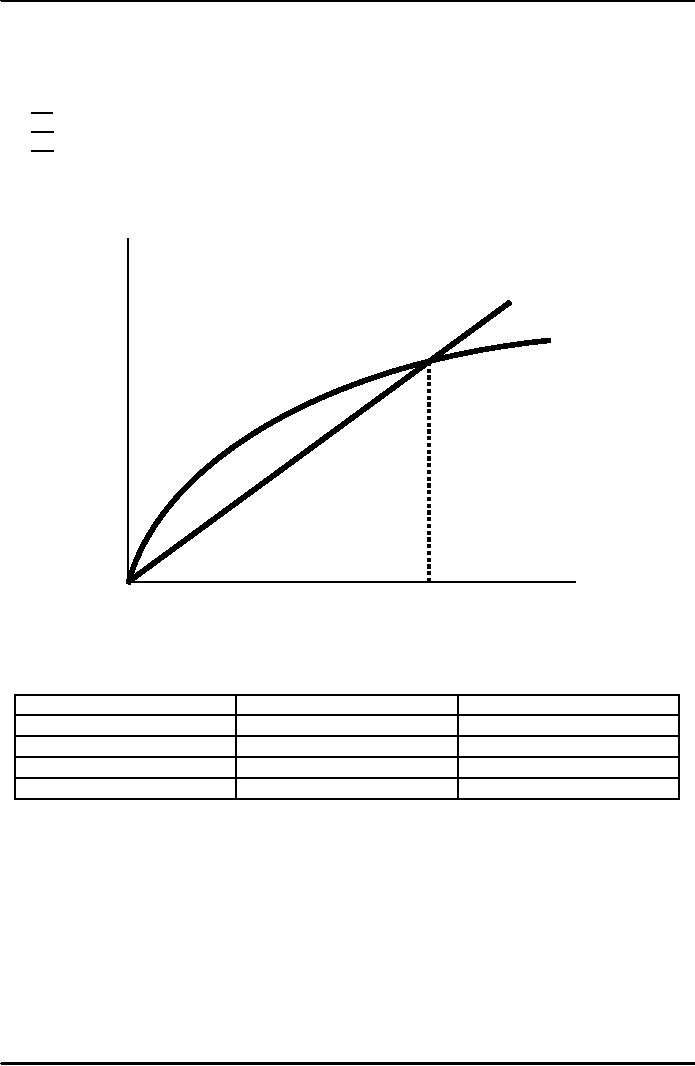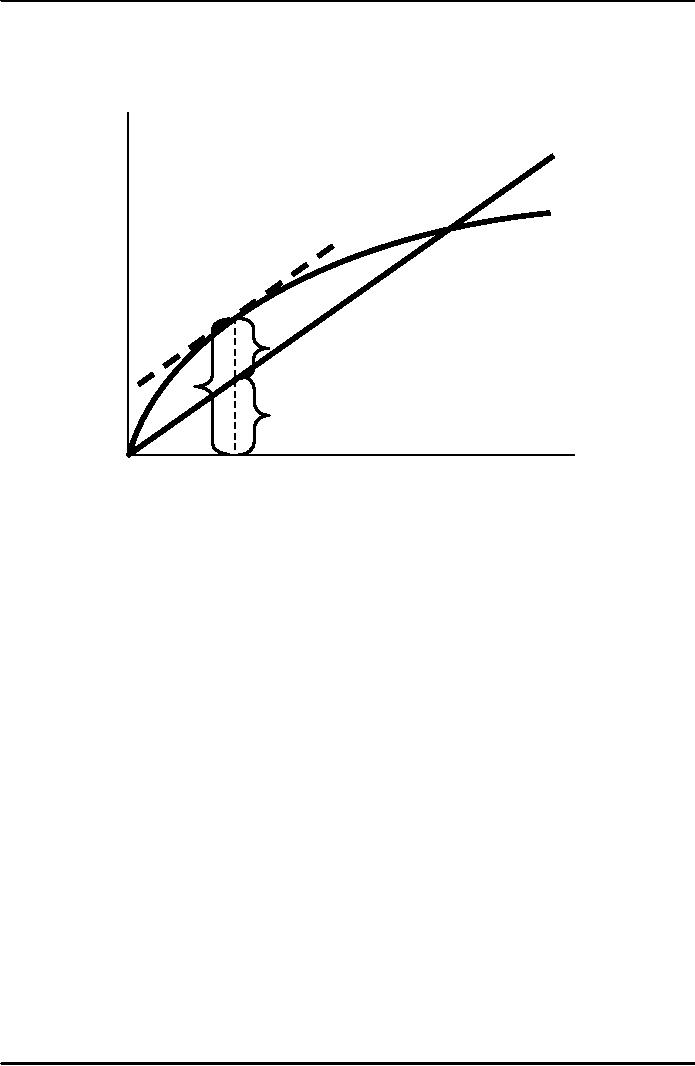 |

Macroeconomics
ECO 403
VU
LESSON
22
ECONOMIC
GROWTH (Continued...)
Issues
under Consideration
·
Technological
progress in the Solow
model
·
Policies
to promote growth
·
Growth
empirics:
Confronting
the theory with
facts
·
Endogenous
growth:
Two
simple models in which the
rate of technological progress is
endogenous
Introduction
Previously,
in the Solow model
·
The
production technology was
held constant
·
Income
per capita was constant in
the steady state.
Neither
point is true in the real
world
Tech.
progress in the Solow
model
·
A
new variable: E = labor
efficiency
·
Assume:
Technological
progress is labor-augmenting: it
increases labor efficiency at
the exogenous
rate
g:
ΔE
g=
E
·
We
now write the production
function as:
Y
= F
(K
, L
× E
)
Where
L ×
E =
the number of effective
workers.
·
Hence,
increases in labor efficiency
have the same effect on
output as
increases
in the labor force.
·
Notation:
y
= Y/LE = output per
effective worker
k
= K/LE = capital per
effective worker
·
Production
function per effective
worker:
y
= f(k)
·
Saving
and investment per effective
worker:
s
y =
s
f(k)
88

Macroeconomics
ECO 403
VU
(δ
+ n +
g)k
= break-even investment:
the
amount of investment necessary to
keep k constant.
Consists
of:
δ
k
to
replace depreciating capital
n
k to
provide capital for new
workers
g
k to
provide capital for the
new "effective" workers
created by technological
progress
Δk
=
s
f(k)
-
(δ
+n
+g)k
Investment,
break-even
investment
(δ
+n
+g
)
k
sf(k)
k*
Capital
per
worker,
k
Steady-State
Growth Rates in the Solow
Model with Tech.
Progress
Variable
Symbol
Steady-Steady
growth rate
k
=
K/
(L
×E
)
Capital
per effective worker
0
y
=
Y/
(L
×E
)
Output
per effective worker
0
(Y/
L
)
= y
×E
Output
per worker
g
Y
=
y
×E
×L
Total
output
n+g
The
Golden Rule
To
find the Golden Rule
capital stock,
express
c*
in
terms of k*:
=
y*
-
i*
c*
=
f(k*
)
-
(δ
+
n
+
g)
k*
c*
is
maximized when
MPK
= δ
+
n
+
g
or
equivalently,
MPK
-
δ =
n
+
g
89

Macroeconomics
ECO 403
VU
In
the Golden Rule Steady
State, the marginal product
of capital net of depreciation
equals the
population
growth rate plus the
rate of tech
progress.
The
Golden Rule Capital
Stock
steady
state
(δ
+n+g)
k*
output
and
investment
f(k*)
C*gold
i*gold =
(δ+
n+g)k*gold
k*gold
steady-state
capital per
worker,
k*
Policies
to promote growth
Four
policy questions:
·
Are we
saving enough? Too
much?
·
What
policies might change the
saving rate?
·
How
should we allocate our
investment between privately
owned physical
capital,
public
infrastructure, and "human
capital"?
·
What
policies might encourage
faster technological
progress?
1.
Evaluating the Rate of
Saving
·
Use
the Golden Rule to determine
whether
our
saving rate and capital
stock are too high,
too low, or about
right.
·
To
do this, we need to
compare
(MPK
- δ
) to (n +
g).
·
If (MPK - δ ) > (n + g),
then we are below the
Golden Rule steady state
and should increase
s.
·
If (MPK - δ ) < (n + g),
then we are above the
Golden Rule steady state
and should reduce
s.
90

Macroeconomics
ECO 403
VU
To
estimate (MPK -
δ ), we
use three facts about an
economy;
1.
k = 2.5 y
the
capital stock is about 2.5
times one year's GDP.
2.
δ
k =
0.1 y
about
10% of GDP is used to
replace depreciating
capital.
3.
MPK ×
k =
0.3 y
Capital
income is about 30% of
GDP
So
1.
k
= 2.5 y
2.
δ
k =
0.1 y
3.
MPK ×
k =
0.3 y
To
determine δ
,
divided 2 by 1:
0.1
δk
0.1 y
⇒
δ =
=
0.04
=
2.5
k
2.5 y
To
determine MPK, divided 3 by
1:
MPK
×
k
0.3 y
0.3
⇒
=
MPK
=
=
0.12
k
2.5 y
2.5
Hence,
MPK -
δ =
0.12 -
0.04 =
0.08
·
Real
GDP grows an average of
3%/year,
so
n + g = 0.03
·
Thus,
in this economy,
MPK
- δ
=
0.08 > 0.03 = n + g
Conclusion:
The
economy is below the Golden
Rule steady state:
if
we increase saving rate of
this economy, the economy
will have faster growth
until it
reaches
to a new steady state with
higher consumption per
capita.
91
Table of Contents:
- INTRODUCTION:COURSE DESCRIPTION, TEN PRINCIPLES OF ECONOMICS
- PRINCIPLE OF MACROECONOMICS:People Face Tradeoffs
- IMPORTANCE OF MACROECONOMICS:Interest rates and rental payments
- THE DATA OF MACROECONOMICS:Rules for computing GDP
- THE DATA OF MACROECONOMICS (Continued…):Components of Expenditures
- THE DATA OF MACROECONOMICS (Continued…):How to construct the CPI
- NATIONAL INCOME: WHERE IT COMES FROM AND WHERE IT GOES
- NATIONAL INCOME: WHERE IT COMES FROM AND WHERE IT GOES (Continued…)
- NATIONAL INCOME: WHERE IT COMES FROM AND WHERE IT GOES (Continued…)
- NATIONAL INCOME: WHERE IT COMES FROM AND WHERE IT GOES (Continued…)
- MONEY AND INFLATION:The Quantity Equation, Inflation and interest rates
- MONEY AND INFLATION (Continued…):Money demand and the nominal interest rate
- MONEY AND INFLATION (Continued…):Costs of expected inflation:
- MONEY AND INFLATION (Continued…):The Classical Dichotomy
- OPEN ECONOMY:Three experiments, The nominal exchange rate
- OPEN ECONOMY (Continued…):The Determinants of the Nominal Exchange Rate
- OPEN ECONOMY (Continued…):A first model of the natural rate
- ISSUES IN UNEMPLOYMENT:Public Policy and Job Search
- ECONOMIC GROWTH:THE SOLOW MODEL, Saving and investment
- ECONOMIC GROWTH (Continued…):The Steady State
- ECONOMIC GROWTH (Continued…):The Golden Rule Capital Stock
- ECONOMIC GROWTH (Continued…):The Golden Rule, Policies to promote growth
- ECONOMIC GROWTH (Continued…):Possible problems with industrial policy
- AGGREGATE DEMAND AND AGGREGATE SUPPLY:When prices are sticky
- AGGREGATE DEMAND AND AGGREGATE SUPPLY (Continued…):
- AGGREGATE DEMAND AND AGGREGATE SUPPLY (Continued…):
- AGGREGATE DEMAND AND AGGREGATE SUPPLY (Continued…)
- AGGREGATE DEMAND AND AGGREGATE SUPPLY (Continued…)
- AGGREGATE DEMAND AND AGGREGATE SUPPLY (Continued…)
- AGGREGATE DEMAND IN THE OPEN ECONOMY:Lessons about fiscal policy
- AGGREGATE DEMAND IN THE OPEN ECONOMY(Continued…):Fixed exchange rates
- AGGREGATE DEMAND IN THE OPEN ECONOMY (Continued…):Why income might not rise
- AGGREGATE SUPPLY:The sticky-price model
- AGGREGATE SUPPLY (Continued…):Deriving the Phillips Curve from SRAS
- GOVERNMENT DEBT:Permanent Debt, Floating Debt, Unfunded Debts
- GOVERNMENT DEBT (Continued…):Starting with too little capital,
- CONSUMPTION:Secular Stagnation and Simon Kuznets
- CONSUMPTION (Continued…):Consumer Preferences, Constraints on Borrowings
- CONSUMPTION (Continued…):The Life-cycle Consumption Function
- INVESTMENT:The Rental Price of Capital, The Cost of Capital
- INVESTMENT (Continued…):The Determinants of Investment
- INVESTMENT (Continued…):Financing Constraints, Residential Investment
- INVESTMENT (Continued…):Inventories and the Real Interest Rate
- MONEY:Money Supply, Fractional Reserve Banking,
- MONEY (Continued…):Three Instruments of Money Supply, Money Demand